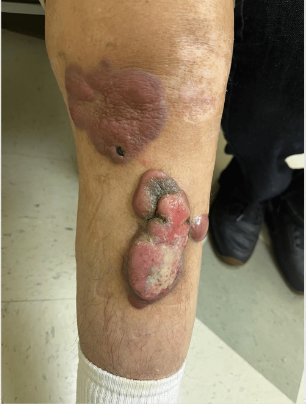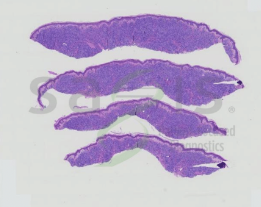Presenter: Francisca Valenzuela, MD, Thomas L Davis, MD, Michael Hohnadel, DO
Dermatology Program: South Texas Dermatology Residency, HCA Healthcare Corpus Christi Medical Center – Bay Area Program
Program Director: Rick Lin, DO MPH FAOCD
Submitted on: September 21, 2023
CHIEF COMPLAINT: Violaceous plaques on left leg
CLINICAL HISTORY: A 91-year-old gentleman with a history of hypertension, gastroesophageal reflux disease, and vitiligo presented to the clinic with two large violaceous ulcerated plaques on his left lower leg. The patient stated that a papule had formed four months prior after a ground-level fall, and it had continued to grow over the last few months, starting to bleed within a few weeks of his appointment. He denied experiencing pain, itchiness, fatigue, or other B symptoms, such as fever, weight loss, or night sweats. The patient also denied recent travel, smoking, using illicit drugs, drinking alcohol, or taking any new medications. His family history was notable for a deceased brother who had an unknown type of cancer. Current medications included carvedilol, doxazosin mesylate, isosorbide mononitrate, omeprazole, loratadine, clopidogrel bisulfate, losartan, benzonatate, and folic acid.
PHYSICAL EXAM:
On physical examination, the patient had two large, well-defined violaceous plaques on the left lower extremity, with no evidence of lymphadenopathy.
LABORATORY TESTS: N/A
DERMATOHISTOPATHOLOGY:
Histopathologic studies revealed dermis with notable proliferation of large, severely atypical lymphoid cells and the presence of mitotic figures.
Immunohistochemistry revealed CD20 positive B-cells.
DIFFERENTIAL DIAGNOSIS:
-
- Lymphomatoid papulosis
- Sarcoidosis
- Cutaneous B-cell Lymphoma
- Sezary Syndrome
- Kaposi Sarcoma
- Mycobacterial Infection
- Cellulitis
- Bacillary Angiomatosis






